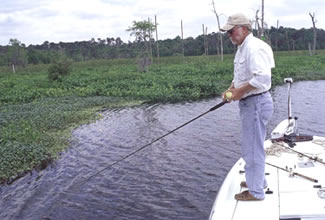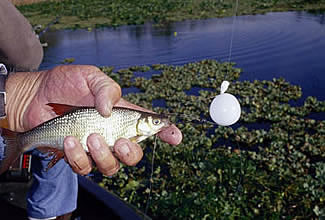May 16, 2011
By Terry Lacoss
The last few years have seen banner bassin' on this Central Florida lake—and it should only get better.
By Terry Lacoss

The dawn patrol launches on a cool and foggy morning. |
The next few minutes would be etched in Jack Healan's mind for eternity.
It all began when Healan's 10-inch wild shiner reached the edge of a large section of floating cabbage weeds. The bait slipped under the weedbed, which turned out to be a costly mistake.
Seconds later, the shiner blasted from under the cover into the open bay, with a very large wake in pursuit. The chase ended in a boil and the small balloon float disappeared into the tannin-stained water.
Healan waited patiently for the bass to swim all of the slack out of the line, while the fish swam straight back under the floating weeds.
“Set the hook hard now, Jack!” guide Jim Allen instructed.
Rod held low, Healan set the hook firmly. Surprisingly, the bass swam out from the weeds, making several jumps at boatside before Allen slipped the landing net under it. Allen reached into the net with a lip-grip device. Healan's bass tipped the scales at just over 10 pounds and was quickly released.
Up to 38 species of fish have been documented in Rodman Reservoir. |
|
Jack announced that his personal bass record had just been broken. For Allen, however, this 10-pounder was just one of many trophies he'd seen during recent days. When the bite is on at Rodman, it's not unusual to boat a half-dozen or more fish nearing or exceeding the magic double-digit mark. In 2000, a 17-pounder was landed on the lake—very close to the Florida record of 17 pounds, 4 ounces. Rodman routinely shows up on the Florida Fish and Wildlife Conservation Commission's list of top bass lakes, which it did again for 2004.
That morning we had joined a long line of bass boats whose owners waited their turn to launch at Kenwood Landing on Rodman Reservoir. The parking lot was almost full, a sign that fishing was good on the 9,600-acre Putnam County lake.
After loading our boat and ensuring the five dozen wild shiners were still alive in the well, the four of us motored through the narrow boat channel into the main lake.
Jim Allen took a right turn, navigating up the old river channel only a mile or so to a shallow bay on the north bank of the reservoir. He then idled slowly through flooded trees and stumps to the very backside of the bay, where a section of floating weeds shut off all navigation to a fairly large feeder creek.
“A few weeks ago, this cove was chuck full of cabbage weeds, hydrilla and grass,” Allen said. “Cold weather killed most of the weeds and sent them down to the bottom. What you see now are small concentrations of floating cabbage weeds and this is where the bass are holding. Just yesterday I had a client here hook a bass that looked to weigh upwards of 15 pounds.”
Allen killed his outboard and began navigating the remaining hundred yards with the electric motor. Within casting distance of the weed-filled creekmouth, we anchored and barbed large, wild shiners on 25-pound casting tackle.

Here's a prime spring bass taken with a live shiner on stout tackle. |
It was a perfect morning for spring bass fishing, mild and with little wind. After 30 minutes of running shiners close to the floating weeds, we had landed three nice largemouth bass to five pounds.
When the bass stopped biting in the shallow bay, Allen motored to the deep, tree-filled waters in the dam section of the reservoir. Here we began slow-trolling our wild shiners, some 40 to 60 feet behind the boat. All were once again floated under small balloons from one to two feet deep. Allen explained our strategy.
“Here I simply fish the edges of the old river channel right up to the dam, while using the electric motor and my fishfinder.”
While slow-trolling livies, we cast plastic worms, black with blue tails, and gold crankbaits to the many stumps and weed beds. With only one missed strike, we relocated to a shallow hump northeast of the mouth of the old Cross-Florida Barge Canal. Here we worked floating weeds and cypress stumps, finishing the day with respectable 3- and 7-pound bass.

Spring anglers spend their time really close to surface vegitation. |
Our trip demonstrated why Rodman annually ranks among Florida's best bass lakes. The reservoir is unique as an example of how a folly of human progress sometimes results in a vital, if unintended, boon to nature. A portion of the Oklawaha River was dammed and flooded in 1968, as part of construction of the Cross-Florida Barge Canal. Work on the canal halted in the 1970s, tangled in litigation and legislation, perceived by many as an unneccessary expense and environmental injustice. The canal idea was eventually scuttled, but the lake that remained has flourished as a bass fishery and wildlife refuge. The 9,600-acre reservoir represented new habitat for some 115 species of water birds, including ospreys, hawks, bald eagles, white ibis, sandhill cranes and a variety of egrets and herons. The vegetation on Rodman—cabbage weeds, water lilies, dollar weeds, hydrilla, hyacinth and more—shelters a variety of aquatic forage, including grass shrimp, mosquito minnows and crawfish. Alligators, turtles, raccoons, muskrat and otters have also found a home in the weedy reservoir.
Up to 38 species of fish have been documented in Rodman Reservoir, including largemouth bass, sunfish, catfish, bowfin, chain pickerel and speckled perch. The reservoir once harbored a nice stock of striped bass, which have since relocated to the river's headwaters at the dam.
There is ongoing debate as to the lake's future—discussion that goes back decades. A few vocal groups calling for the removal of the dam and restoration of the old Oklawaha River have garnered political support, but so far the la
ke's many advocates have kept the fishery intact. The feisty Save Rodman Reservoir Inc., headed by tireless Palatka resident Ed Taylor, continues to press for a state bill to protect the status of the reservoir. State Sen. Rod Smith and Rep. Joe Picken were pressed for a new Rodman Reservoir Bill this year, outlining the environmental and recreational benefits of the lake, plus news about its potential value to the state drinking water supply.
For now at least, Florida is committed to keeping Rodman in optimal condition for fish and wildlife. Every three years the Department of Environmental Protection lowers the water level—from about 18 feet to 11 feet—for a number of weeks in midwinter. Mimicking natural fluctuations in wetlands, these drawdowns help thin out non-native vegetation, and clear the lake bottom for growth of desirable plant species. Birds and other wildlife also enjoy the drawdowns—but perhaps not nearly so much as fishermen.
As many anglers anticipated, the drawdown of 2004-'05 saw excellent fishing in Rodman Reservoir. With hungry bass concentrated in narrow channels, the state implemented a special all-release regulation for the lake, from December 1, 2004 to April 1, 2005. Temporary boat ramps were cleared to make way for boaters. The Web site rodmanreservoir.com and other sources helped explain changes in navigation. As the water level began rising following the drawdown, Taylor and other lake advocates expected excellent spawning conditions for largemouth bass.
Rodman Access |
There are several boat ramps and camps located on or near Rodman Reservoir, including the Rodman Campground. Rodman Campground is located just off State Road 19 and has clean showers and restroom facilities. There is also a fulltime security guard living on the campground. A handicap-accessible fishing pier has been constructed at the Kirkpatrick Dam, giving fishermen access to the dam's spillway waters. Here, fishermen will find a double boat ramp and clean restrooms, too. For more information on camping and boat ramps on Rodman Reservoir, visit www.rodmanreservoir.com. One source for wild golden shiners (often hard to find) is Orange Spring's Howard's Wild Shiners, (352) 546-1213. |
|
In general, “Bass fishing is the best it has been for many years on Rodman,” claims Jim Allen, who normally guides on the main lake portion of Rodman Reservoir and the old river channel that runs west from Kenwood Landing. Allen does a lot of shiner fishing, but he also throws plastic worms and crankbaits on light tackle. One of his favorite lures is an 8-inch black plastic worm with a blue curly tail. The worm is rigged on a 5/0 hook and weighted with a 1/4-ounce black bullet weight, fished on 12-pound-test line. Allen also casts a gold Rapala Shad Rap when the bass are deep, and black buzzbaits when the fish are feeding close to the surface.
“During the warmer months, I target the edges of the deep river channels and portions of the dam and open lake, where we often freeline big shiners under floating weedbeds,” said Allen. “In winter, I look for the three days prior to a full moon during the month of January and three days following the full moon to produce some of the best fishing of the year on shallow bays. However, I don't like to fish right on the day of the full moon.”
Allen said there used to be some 20 guides working Rodman Reservoir, but for one reason or another there are only around five full-time guides. “However, with the way the bass fishing has improved during the last few years, I expect there will be more people fishing and guiding here.”
Slick Shiner Tricks
Think there's no science to dunking a live shiner for largemouth bass? Think again. Bass guide Jim Allen showed us some specialized techniques for weed-filled waters, starting with coating the fishing line with flyline dressing.

Wild shiner with balloon float, a deadly combo for big bass. |
“I dip a small cloth into a jar of flyline dressing and coat the fishing line from the hook to some 10 feet of the fishing line back to the reel,” he explained. “This helps the fishing line float, keeping it from sinking to the bottom and tangling with weeds. More importantly, the fishing line slips through the weeds like a greased pig when a big bass takes a bait in heavy cover. If the line were to snag, the fish may feel the resistance and turn the shiner loose.”
Allen employs small balloons when floating large wild shiners next to floating weeds. “I use a small helium balloon and tie it to the fishing line some two feet above the shiner,” instructs Allen. “As the bass runs under the weedbeds, the fishing line will actually slip through the knot of the balloon, so it doesn't put any undue pressure on the bass. I stopped using a regular cork float many bass fishing seasons ago, because the pegged cork would snag nearby weeds and let the hooked bass know that something is definitely not right with the shiner that she has just eaten.”
Allen uses a 3/0 or 4/0 weedless Eagle Claw livebait hook, barbing the live shiner right through the open mouth and out through one of the nostrils. He also uses 20- or 25-pound fishing line, with a hard finish in green. The hard finish is an advantage when the line contacts fallen trees, stumps and weed. He uses a levelwind casting reel on a stiff, 6-foot casting rod. Drag is tightened all the way down when fishing weedbeds.
Allen also recommends holding the rodtip low to the water when a bass takes a shiner under floating weeds. Wait until the bass swims out all of the slack, then set the hook, again keeping the rodtip low, even while playing the fish. The low rodtip position helps keep the line from tangling in the weeds.
FS

